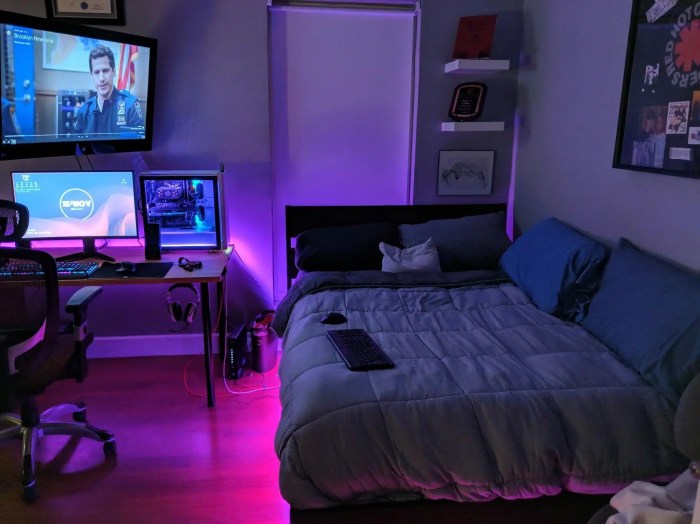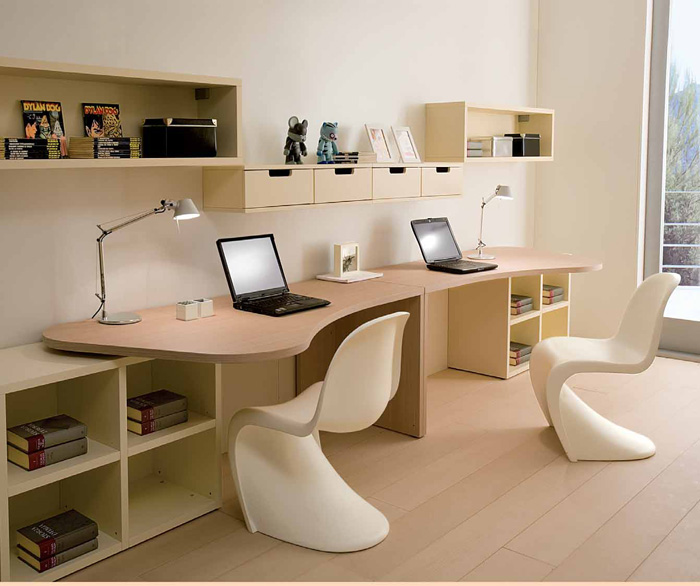Creating a comfortable and ergonomic bedroom setup for teens is crucial for their physical and mental well-being. With the increasing time spent on studying, gaming, and social media, it’s essential to provide them with furniture that supports their growing bodies and promotes good posture.
This guide will delve into the importance of ergonomics in teen bedrooms, explore various types of ergonomic furniture, and offer design considerations and tips for incorporating these elements into their space. By following these recommendations, you can create a bedroom environment that fosters both comfort and productivity for your teen.
Ergonomics in Teen Bedroom Setups
Ergonomics plays a crucial role in shaping healthy living spaces for teenagers. As their bodies and minds undergo significant growth and development, creating an ergonomic bedroom setup can provide numerous health benefits and enhance their overall well-being.Teenagers spend a substantial amount of time in their bedrooms, engaging in activities such as studying, sleeping, and socializing.
Poor ergonomics can lead to discomfort, musculoskeletal pain, and even long-term health issues. By incorporating ergonomic principles into their bedroom setups, teens can minimize these risks and create a more comfortable and supportive environment.
Choosing Ergonomic Furniture for Teens
When selecting ergonomic furniture for teens, consider the following tips:
-
-*Adjustable Furniture
Choose furniture that allows for height and angle adjustments to accommodate their growing bodies. This includes desks, chairs, and beds.
-*Proper Back Support
Opt for chairs with lumbar support to maintain proper posture and reduce back strain.
-*Comfortable Cushioning
Look for chairs and beds with adequate cushioning to provide support and prevent pressure points.
-*Non-Slip Surfaces
Choose furniture with non-slip surfaces to prevent accidents and ensure stability.
-*Adequate Lighting
Provide ample natural and artificial lighting to reduce eye strain and promote alertness.
Types of Ergonomic Furniture for Teen Bedrooms

Ergonomic furniture is designed to provide comfort, support, and improve posture. It can help teens avoid back pain, neck strain, and other health problems.
There are many different types of ergonomic furniture available for teen bedrooms, including:
Adjustable Desks
Adjustable desks allow teens to change the height of their work surface to find the most comfortable position for their body. This can help prevent neck and shoulder pain, as well as improve posture. Some adjustable desks also have features like built-in storage and charging stations, making them a great option for teens who need a functional and stylish workspace.
Example: The Flexispot EC1 Standing Desk is an adjustable desk with a height range of 22.8″ to 48.4″. It has a spacious work surface, a built-in drawer, and a USB charging port.
Ergonomic Chairs
Ergonomic chairs are designed to provide support for the back, neck, and arms. They typically have adjustable features, such as lumbar support, seat height, and armrests, so teens can customize the chair to fit their body perfectly. Ergonomic chairs can help prevent back pain, neck strain, and carpal tunnel syndrome.
Example: The Herman Miller Aeron Chair is a high-end ergonomic chair that offers exceptional support and comfort. It has adjustable lumbar support, seat height, and armrests, as well as a breathable mesh back that helps keep teens cool and comfortable.
Adjustable Beds
Adjustable beds allow teens to change the position of their bed to find the most comfortable position for sleeping. This can help improve sleep quality and reduce back pain. Some adjustable beds also have features like built-in massage and heat therapy, making them a great option for teens who want to relax and unwind before bed.
Example: The Saatva Solaire Adjustable Bed is an adjustable bed with a variety of features, including adjustable head and foot positions, built-in massage, and heat therapy. It also has a wireless remote control for easy operation.
Design Considerations for Teen Bedroom Setups with Ergonomic Furniture
Ergonomic design is not just about choosing the right furniture; it also involves creating a harmonious and supportive space. When designing a teen bedroom with ergonomic furniture, consider these factors:
Space Planning and Layout
Plan the layout to ensure a clear flow of movement. Place the bed, desk, and storage units in a way that maximizes space and minimizes clutter. Use vertical storage solutions to keep the floor clear.
Colors, Lighting, and Accessories
Choose calming colors and adequate lighting to create a conducive environment for relaxation and study. Avoid harsh lighting or excessive clutter. Incorporate plants and other natural elements to enhance well-being.
Ergonomic Bedroom Design Examples
| Room Size | Design Features |
|---|---|
| Small (10′ x 10′) | Wall-mounted bed, under-bed storage, floating desk, built-in shelves |
| Medium (12′ x 12′) | Corner desk, adjustable chair, full-length mirror, ottoman with storage |
| Large (14′ x 14′) | Separate study area with ergonomic chair, standing desk, reading nook, storage bench |
Benefits of Teen Bedroom Setups with Ergonomic Furniture
Ergonomic furniture in teen bedrooms offers a range of physical and mental health benefits that can enhance their well-being and academic performance. By providing proper support and reducing strain, ergonomic setups promote good posture, alleviate discomfort, and foster a productive environment.
Improved Posture
Ergonomic chairs and desks are designed to align the spine, reducing the risk of back pain, neck pain, and other musculoskeletal issues. By maintaining proper posture, teens can improve their breathing, circulation, and overall comfort, allowing them to focus better on their studies and activities.
Reduced Strain
Ergonomic furniture reduces physical strain by providing adequate support for the body. Adjustable desks allow teens to find the optimal height for their height and activities, minimizing strain on the wrists, neck, and shoulders. Ergonomic chairs with lumbar support help maintain a healthy curvature of the spine, reducing the risk of lower back pain.
Increased Productivity
A comfortable and supportive environment can significantly enhance productivity. By reducing physical discomfort and distractions, ergonomic furniture allows teens to concentrate better on their tasks, whether it’s studying, working on hobbies, or simply relaxing. Improved posture and reduced strain can lead to increased energy levels and a more positive outlook, further contributing to their overall productivity.
Testimonials
“Since I started using an ergonomic chair and desk in my bedroom, I’ve noticed a huge difference in my posture and energy levels. I used to get back pain and headaches all the time, but now I feel much more comfortable and focused when I’m studying or working on my hobbies.”
Sarah, 16
“I used to have trouble concentrating because my old desk and chair were too uncomfortable. Now that I have an ergonomic setup, I can sit for longer periods without getting fidgety or tired. It’s made a big difference in my grades and my overall well-being.”
Ethan, 17
Tips for Incorporating Ergonomic Furniture into Teen Bedroom Setups
Incorporating ergonomic furniture into teen bedroom setups is essential for promoting comfort, health, and well-being. By following these tips, you can create a space that supports your teen’s physical and mental health while fostering a comfortable and stylish environment.
Step-by-Step Setup Guide
- Choose adjustable furniture: Select desks, chairs, and beds that allow for height and position adjustments to accommodate your teen’s growing body.
- Set the desk at the correct height: The desk should be at elbow height when your teen is sitting with their feet flat on the floor and their back straight.
- Adjust the chair: The chair should provide adequate lumbar support and allow your teen’s feet to rest flat on the floor. The seat height should be adjustable to maintain a 90-degree angle at the knees.
- Position the bed: The bed should be placed in a way that allows your teen to get in and out of it easily. The headboard should be high enough to support their head and neck.
- Add accessories: Consider adding ergonomic accessories such as footrests, lumbar support cushions, and anti-fatigue mats to enhance comfort and support.
Creating a Comfortable and Stylish Space
While ergonomics is essential, it’s also important to create a space that reflects your teen’s personality and style. Consider these tips:
- Choose furniture in a color scheme that complements your teen’s decor: This will help the furniture blend seamlessly into the room.
- Add personal touches: Allow your teen to express their creativity by adding artwork, photos, or other decorative items that reflect their interests.
- Keep the room organized: A cluttered space can be both uncomfortable and distracting. Encourage your teen to keep their belongings organized using storage solutions like shelves, drawers, and baskets.
Summary
Incorporating ergonomic furniture into teen bedroom setups is an investment in their health and well-being. By providing them with adjustable desks, chairs, and beds, you can help them maintain good posture, reduce strain, and improve their overall comfort. Remember to consider their personal preferences and space constraints when selecting furniture and designing their bedroom layout.
With careful planning and thoughtful choices, you can create a bedroom that supports their physical and mental growth, allowing them to thrive in all aspects of their lives.

